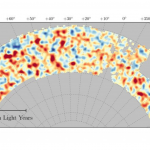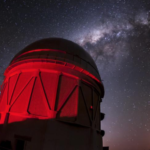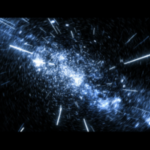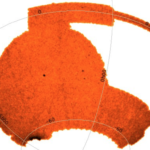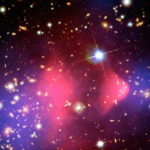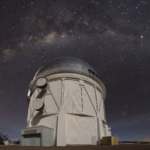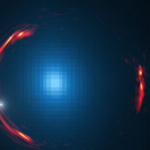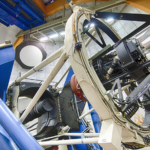All the news about DES that’s fit to print!
Dark energy tests prove science is right about the universe
The results are in: As best we can tell, the universe clumps and expands just how we thought it did. That confirmation comes from the first results of a five-year survey wherein researchers took dark energy into account, observing much more recent cosmic activity than previous methods allowed. The new method: Strapping a 570-megapixel camera to a 4-meter telescope in the Chilean mountains and snapping photos of light streaming across space from as far back as 7 billion years ago.
This setup, known as the Dark Energy Camera (or DECam), shot its first photos back in 2012. Researchers used it for this study, the Dark Energy Survey (DES), an international effort that analyzed light from 26 million galaxies to learn how cosmic bodies have changed over the last 7 billion years. That spans the last half of our universe’s lifespan, which is far more recent than the previous method, which used the European Space Agency’s Planck telescope (retired in 2013) to scan cosmic background radiation from the origins of the universe.
Scientists one step closer to solving the mysteries of dark matter and dark energy with new map
The universe is made up of matter and energy, but only a fraction of it can be directly observed. The majority of the matter in the universe is comprised of dark matter, a mysterious substance which can only be detected by virtue of its gravitational effects on visible objects. Likewise, dark energy is also at work, and is a poorly understood force with tremendous power. Dark energy is accelerating the expansion of the universe.
Scientists are working to figure out exactly what dark matter and dark energy are. There is a lot more material in the universe than we can detect, and nobody is sure why this is so. Without dark matter, galaxies would fly apart in all directions, scattering their stars across the universe.
New Map of the Universe Probes the Enduring Mystery of Dark Matter
Mapping the entire universe is no mean feat, necessitating a tremendous amount of manpower and a good deal of innovation. Four hundred scientists from seven countries were involved in the project, collaborating to build a 570-megapixel camera for use at the four-meter Victor M. Blanco telescope at the Cerro Tololo Inter-American Observatory in Chile.
Scientists make most accurate measurement of elusive dark matter
Scientists have made the most accurate measurement ever of the dark matter in the present-day universe, providing support to the theory that the elusive particle makes up majority of the cosmos.
The measurements of the amount and “clumpiness” (or distribution) of dark matter were made with a precision that, for the first time, rivals that of inferences from the early universe by the European Space Agency’s orbiting Planck observatory.
Dark Energy Survey Reveals Most Accurate Measurement of Dark Matter Structure in the Universe
Dark Energy Survey (DES) scientists, including astronomers at Texas A&M University, are celebrating the release of the most accurate measurement to date of the present large-scale structure of the universe.
DES scientists unveiled their most recent findings in a presentation today (August 3) at the American Physical Society Division of Particles and Fields meeting at the U.S. Department of Energy’s (DOE) Fermi National Accelerator Laboratory. Their measurements of the amount and “clumpiness,” or distribution, of dark matter in the present-day cosmos were made with a precision that, for the first time, rivals that of inferences from the early universe by the European Space Agency’s orbiting Planck observatory, enabling scientists to understand more about the ways the universe has evolved over 14 billion years.
“This result is beyond exciting,” said Scott Dodelson of Fermilab, one of the lead scientists on this result. “For the first time, we’re able to see the current structure of the universe with the same clarity that we can see its infancy, and we can follow the threads from one to the other, confirming many predictions along the way.”
El Dark Energy Survey (DES) publica la medida más precisa jamás hecha de la estructura de la materia oscura en el universo
Los resultados de esta investigación, fruto de la colaboración internacional de más de 400 científicos de 26 instituciones en siete países, confirman que la materia oscura y la energía oscura componen la mayor parte del cosmos. Investigadores españoles del CIEMAT, del Institut de Ciències de l’Espai (IEEC-CSIC), del Institut de Física d’Altes Energies (IFAE) y del Instituto de Física Teórica de la Universidad Autónoma de Madrid y el CSIC participan en este relevante trabajo científico.
Into the Unknown: Researchers Think They’ve Proven the Existence of Dark Matter
A new map of the universe has been unveiled by scientists, revealing the last seven billion years of cosmic history. The researchers believe their findings support the notion a mere four percent of the universe is comprised of “ordinary” matter, the rest “dark” – matter that is largely unknownable and in many cases simply theoretical.
Astronomers Unveil Most Accurate Map Of Dark Matter In The Univers Newburgh Gazette
Today we can use the fact that mass changes space to “see” dark matter by measuring how light behind it distorts as it passes by, giving us a way to measure the amount and distribution of both kinds of matter across a portion of the Universe. The results are part of the Dark Energy Survey, and show how dark matter is distributed across the galaxy – scientists hitherto used models to show where it fell, largely based the Standard Model of particle physics, an incomplete theory that was nonetheless the best explanation of how matter across the universe interacts.
Most accurate measurement of universe’s dark matter unveiled
What is our universe made of, and has its composition changed over time?
Though postulated as far back as 1884 by Lord Kelvin (for whom the kelvin temperature scale is named), dark matter remained an elusive subject for study until the 1930’s. The DES project is a pathfinder for the next generation of surveys, the Large Synoptic Survey Telescope (LSST).

